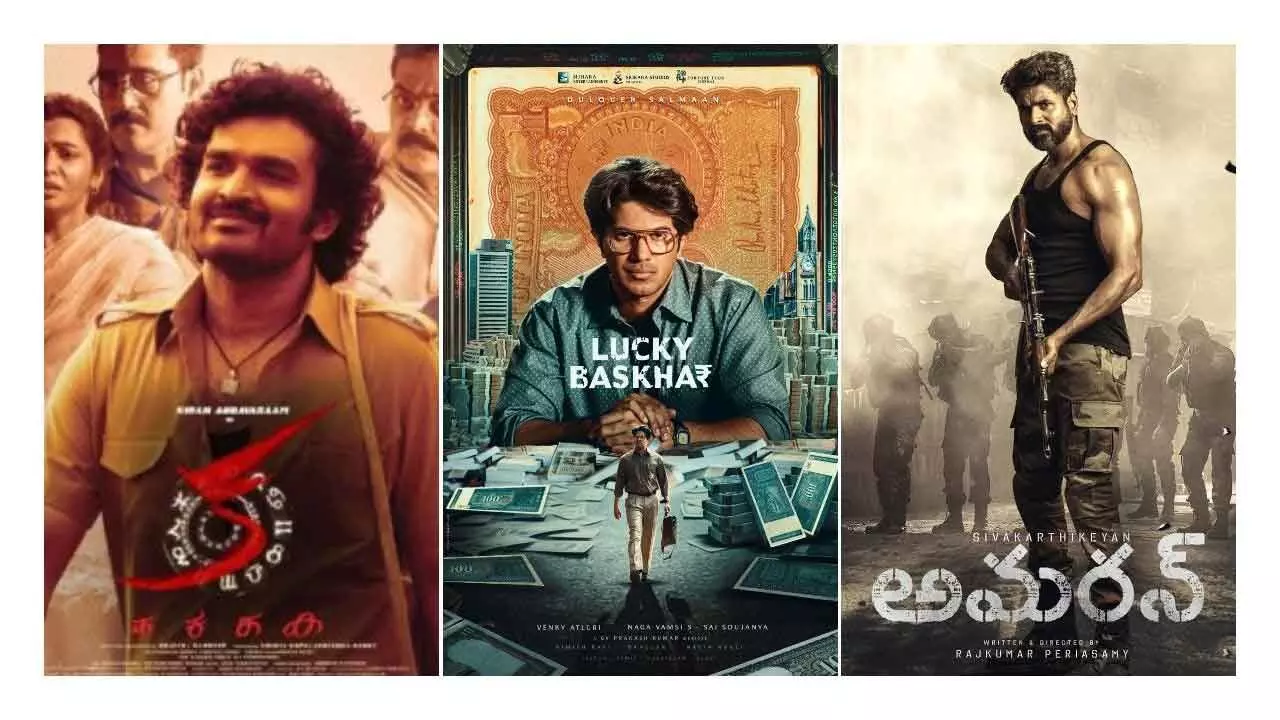What Is Common Among Amaran, Lucky Bhaskar, and KA?

Indian Cinema Pursuing Period Films for a Specific Reason?
Indian cinema has recently experienced a noticeable shift, particularly within the Telugu and Tamil film industries. This transformation has sparked a growing interest in period films, raising the question: why are filmmakers increasingly drawn to this genre?
A Shift in Focus
Before the pandemic and the rise of OTT platforms as primary avenues for cinematic consumption, films typically catered to specific demographics. With diverse content now accessible in homes, the emphasis has shifted to what’s fresh and unique in storytelling. While Lagaan once stood as the gold standard for Indian period films, subsequent releases have struggled to achieve similar acclaim, particularly from South India.
Telugu filmmakers have been hesitant to delve into period films until recently, largely due to the challenges of historical accuracy and the meticulous attention to detail required in this genre. Additionally, budget constraints often limit the ability to hire skilled cast and crew necessary to bring such stories to life.
The Influence of Blockbusters
The landscape began to change dramatically with the release of Rajamouli's Baahubali and RRR. These films not only captivated audiences but also set a new benchmark for Indian cinema. Rajamouli’s insight into the industry reflects a broader truth: We think that movies are everything. But proportionally, only 10% of people are watching movies. The rest have other entertaining hobbies. This acknowledgment underscores the importance of creating compelling content that engages viewers in meaningful ways.
As audiences adapt to a new cinematic reality shaped by global influences and the proliferation of OTT platforms, filmmakers face the responsibility of ensuring their works resonate deeply with viewers. With more people watching films than ever before, there is a collective desire for quality storytelling that justifies the investment of time and money.
Recent Trends and Upcoming Releases
At the press meet for the movie Kanguva, actor Suriya credited Rajamouli for putting South Indian cinema on global platforms. He confidently declared that his upcoming release would be another 300, Apocalypto, and Baahubali. Let's wait and see how it turns out.
Regarding the Diwali releases of 2024: KA, Lucky Bhaskar, Amaran, Bhageera, Singham Again, and Bhool Bhulaiyaa 3, each film has made a strong effort to appeal to pan-Indian and global audiences at all levels.
KA: KA is a period film that offers a unique take on filmmaking. The audience is kept completely in the dark, with only hints about the probable climax that can only be realised after witnessing the end, but one could never guess it. This approach is both new and brave for directors Sujith and Sandeep. Credit for believing in such an experimental script goes to Kiran Abbavaram and the producers.
Lucky Bhaskar: Another period film, it is a perfectly rich blend of emotions and the everyday financial struggles of a common man. The film succeeds largely due to the brilliant portrayal by the protagonist. Dulquer Salman's nuanced performance creates a deep connection with viewers, evolving from a subdued presence to a dynamic range of emotions. The film shines thanks to Venky Atluri's insightful writing.
Amaran: A nostalgic ode to love for the Indian Army, it offers a unique and expansive journey, weaving personal experiences of an army wife, who has always been and will be in a long distance relationship, into a narrative that resonates universally. This film exemplifies a trend toward exploring localised stories that maintain global relevance, similar to the earlier success of Kantara. The film avoids any pacing issues or dragging moments.
All three of the above films are period pieces released on the same day. To everyone’s surprise, they are all doing well with critics, audiences, and at the box office.
Bhageera: Although it's not strictly a periodic film, its making is inspired by the period film KGF. The movie begins with a similar tone and even uses the same colour palette. The story also borrows elements from KGF, including a romantic subplot and the transformation of an ordinary policeman into a superhero.
Bhool Bhulaiyaa 3: This film retells the classic Manichitrathazhu, adding its own original twists and comedic elements. It brings back Vidya Balan and features additional stars to enhance the storytelling with more colour and flavour. The results speak for themselves; it has performed well at the box office.
Singham Again: This instalment includes mythological connections to create a sense of familiarity for the audience, representing a new approach to reach a wider demographic rather than focusing on specific sections.
The New Era of Indian Cinema
The success of these films highlights a significant shift in Indian cinema. The landscape is evolving; regional cinema as we once knew it is fading, giving way to narratives that strive for universal appeal. Filmmakers are increasingly aware of the need to create works that resonate beyond cultural boundaries, ensuring audiences feel their time and money are well spent.
Looking ahead, upcoming releases like Kanguva and Matka promise to continue this trend, showcasing compelling stories while appealing to a diverse audience. As Indian cinema embraces this new era, it is clear that period films will play a pivotal role in shaping its future.




















